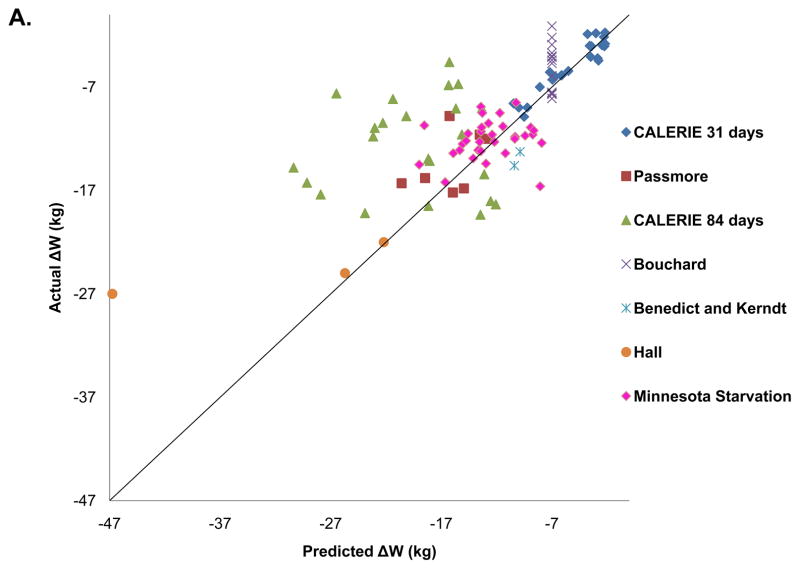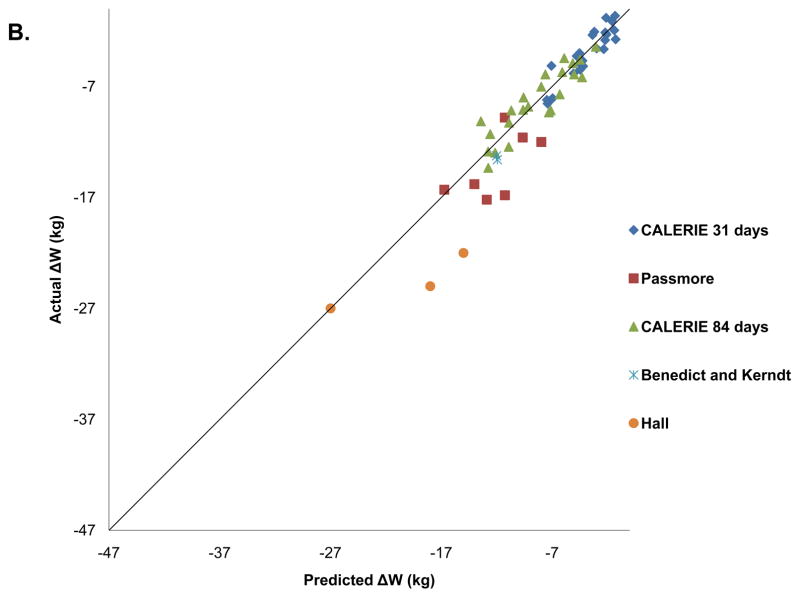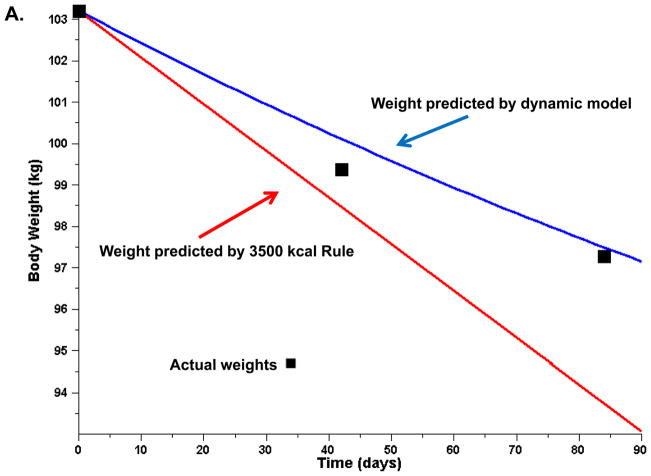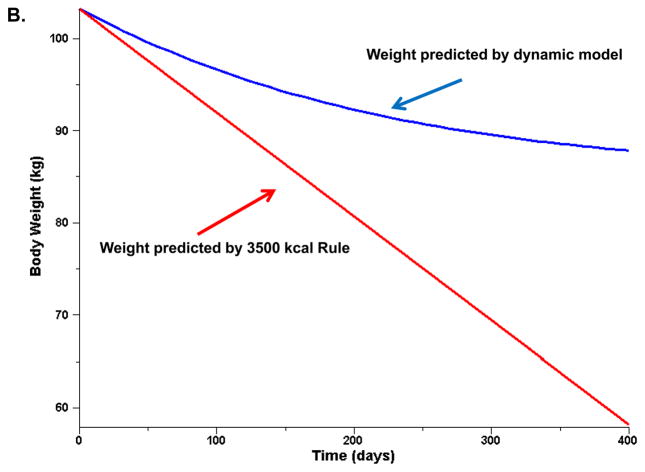Abstract
Despite theoretical evidence that the model commonly referred to as the 3500 kcal rule grossly overestimates actual weight loss, widespread application of the 3500 kcal formula continues to appear in textbooks, on respected government and health related websites, and scientific research publications. Here we demonstrate the risk of applying the 3500 kcal rule even as a convenient estimate by comparing predicted against actual weight loss in seven weight loss experiments conducted in confinement under total supervision or objectively measured energy intake. We offer three newly developed, downloadable applications housed in Microsoft® Excel and Java which simulates a rigorously validated, dynamic model of weight change. The first two tools available at www.pbrc.edu/sswcp, provide a convenient alternative method for providing patients with projected weight loss/gain estimates in response to changes in dietary intake. The second tool which can be downloaded from the URL, www.pbrc.edu/mswcp, projects estimated weight loss simultaneously for multiple subjects. This tool was developed to inform weight change experimental design and analysis. While complex dynamic models may not be directly tractable, the newly developed tools offer the opportunity to deliver dynamic model predictions as a convenient and significantly more accurate alternative to the 3500 kcal rule.
Keywords: 3500 kcal Rule, Wishnofsky’s Rule, Dynamic Model, Energy Balance, First Law of Thermodynamics
INTRODUCTION
What is a safe, achievable and clinically meaningful goal for weekly weight loss? This question is central for anyone attempting to lose weight to improve health. Despite the recent development and rigorous validation of complex mathematical models which answer this question (1, 2), expected weight loss is often guided by the belief that a 3500 kilocalorie (kcal) deficit will result in one pound of weight loss (about 0.45 kilogram) (3). This simple weight loss rule continues to be cited in over 35,000 weight loss educational websites as well as multiple nutrition textbooks (4, 5), scientific articles (6–10), and expert guidelines (11). Even the U.S. Surgeon General continues to provide weight loss guidelines based on the 3500 kcal rule (http://www.surgeongeneral.gov/library/calls/obesity/fact_whatcanyoudo.html). Presumably, continued application of the 3500 kcal rule is based on its computational simplicity which requires at most a simple calculation. Here we demonstrate the risk of applying the 3500 kcal rule even as an estimate. We offer three newly developed, downloadable applications housed in Microsoft® Excel and Java which simulates a rigorously validated, dynamic model of weight change. The first two tools available at www.pbrc.edu/sswcp, provide a convenient alternative for providing patients with projected weight loss/gain estimates in response to changes in dietary intake. The second tool which can be downloaded from the URL, www.pbrc.edu/mswcp, projects estimated weight loss for multiple subjects and was developed to inform weight change experimental design and analysis.
METHODS
Predictions of weight in pounds by the 3500 kcal rule were determined from the following equation:
where t represents the day of negative energy balance, ΔEB is the change in energy balance in kcal/d defined as the difference between the rate of energy intake and the rate of energy expenditure, W0 is baseline weight in pounds, and W(t) represents the expected weight (pounds) on day t. To test the 3500 kcal rule against observed weight loss data, we searched the literature for weight loss experiments where compliance to diet and exercise interventions were directly supervised in confined subjects or through multiple clinical measurements of changed body energy stores and total daily energy expenditures. A total of seven studies met the required criteria (12–18). Five of the studies were performed under confinement conditions with subjects fully monitored at all times (12–16). A sixth study confirmed dietary compliance by conducting multiple simultaneous measurements of changes in body energy stores and energy expenditures (17). The final study was the classic Minnesota Semi-starvation Experiment where subjects were housed in residence and carefully supervised at all meals and throughout the day (18).
A subset of the 7 selected studies were applied to compare a validated thermodynamically based model’s predictions (2). The dynamic model was developed to predict changes to body weight in response to a negative energy balance resulting from calorie restriction or a low dose of exercise (2). Participants in the Bouchard study (13) performed a high dose of exercise which induced changes to body composition that differ from calorie reduced dynamics (19). Additionally, the dynamic model requires input of baseline age, height, gender, and weight in weight stable individuals. The Minnesota Semi-Starvation Experiment (20) did not publish individual baseline weights prior to weight change. Thus, these two studies could not be simulated using the dynamic model.
Overall, the data presented in Figure 1 represents a total of 103 adults, 71 men and 32 women, with a baseline body weight (Mean±SD) of 82.1±22.0 kg and baseline energy intake of 2876±484 kcal/d. Subjects were prescribed a target intake of 1409±569 kcal/d, an average deficit of 1439±784 kcal/d. The duration of treatment was 64.8±23.6 days with a range of 31 to 93 days.
Figure 1.
Panel A Actual change in weight versus 3500 kcal rule predicted change in weight (kg) with the 3500 kcal rule using raw data from (12–18). Panel B Actual change in weight versus the dynamic model predicted change in weight (kg)†. The 3500 kcal rule overestimates weight loss in most cases. †The dynamic model was simulated solely for caloric restriction studies which published necessary individual subject inputs such as age, height, gender, and baseline weight (12, 14–17).
RESULTS AND DISCUSSION
How well does the 3500 kcal rule predict weight loss?
The comparison of actual change in weight to predicted change in weight is shown in Figure 1 A. As illustrated, the majority of subjects exhibited substantially less weight loss than the amount predicted by the 3500 kcal rule. Subjects lost 20.1±11.3 lbs, 7.4±12.6 lb less than the 27.6±16.0 lbs predicted by the 3500 kcal rule.
These discrepant results led us to hypothesize that the self-limiting nature of weight loss is best captured by thermodynamically-based models (1, 2) and not by the 3500 kcal rule. The dynamic weight loss models are based on the first law of thermodynamics, dependent on baseline body composition, age, height, gender, and degree of caloric restriction, and result in a curvilinear pattern of weight loss over time rather than the linear pattern predicted by the 3500 kcal rule. In the 5 studies which satisfied the model assumptions and inputs, subjects lost 17.0 ± 11.0 lbs in comparison to the dynamic model (21) predicted 18.4 ± 13.8 lbs (Figure 1 B). The validated dynamic weight loss model (21) predicted a weight loss of 14 lbs in the Comprehensive Assessment of Long-term Effects of Reducing Intake of Energy(17) (CALERIE) Phase I subject presented in Figure 2A, very close to the 13 lbs actually observed. The weight loss trajectory predicted over 400 days by the dynamic weight loss model for the same subject is shown in Figure 2B. Beyond one-year the deviation between weight loss predicted by the dynamic model and that predicted by the 3500 kcal rule is substantial. A plateau with energy equilibrium is predicted by the dynamic model to be reached at 1.4 yrs.
Figure 2.
Figure 2 A Simulation of weight loss calculated with the 3500 kcal rule (red line) and a dynamic weight loss model (2) (blue line) for a 103 kg (227 lb) male with a caloric deficit of 867 kcal/d in the CALERIE trial(17). Based on repeated measures of body composition and energy expenditures, this subject was considered compliant because actual and prescribed energy intakes were within ±1%.
Figure 2 B Long-term predictions of weight loss for the same subject (17) undergoing 25% caloric restriction demonstrate the discrepancy between weight loss predicted with the 3500 kcal rule and the dynamic model (2), the latter of which predicts a weight plateau after 1.4 years.
Downloadable weight change predictor
Our analysis demonstrates that the 3500 kcal rule significantly overestimates the magnitude of weight loss. Since the 3500 kcal rule is often applied to arrive at a quick estimate of weight loss, a simple but better alternative is required to replace it. Web-based calculators that simulate validated models such as (http://www.pbrc.edu/research-and-faculty/calculators/weight-loss-predictor/, http://bwsimulator.niddk.nih.gov/) offer such an alternative. While web-based calculators make complex models accessible for application, they still rely on an internet connection and do not allow input for different choices of dietary intake (as total daily intake versus increase or decrease above baseline levels). Moreover, printing graphical output is only possible by printing the screen, and graphs cannot be enlarged nor can viewpoints be altered.
To increase the simplicity and flexibility of these existing calculators, we developed three applications that simulate a validated dynamic model (2). The first calculator available at www.pbrc.edu/sswcp is designed for individual use with input of user-designated energy intake inputs; increased or decreased calorie intake above baseline requirements, or as targeted total caloric intake. The program was developed using the Visual Basic Application within Microsoft® Excel allowing for users to download a permanent copy to their personal computer, view daily predictions, and print simulated weight graphs. Additionally, all usual changes in Excel can be applied to alter the design of the weight graph. Finally, users can choose to compare dynamic model predictions to the 3500 kcal rule which is simultaneously plotted with the dynamic model predicted graph. Similar features were developed using a Java software platform, also available at www.pbrc.edu/sswcp. The third program available at www.pbrc.edu/mswcp was also developed using the Visual Basic Application within Microsoft® Excel to simultaneously generate weight change predictions for multiple individuals. Similar to the single subject program, users enter baseline age, height, gender, weight, duration of the intervention, and target intake by interacting with a simple user interface to obtain dynamic predictions of weekly weight change. The multi-subject simulator is the first program to provide dynamic predictions for more than one individual at a time and provides a convenient and simple method to generate predictions critical for weight change experimental design and analysis.
Acknowledgments
The authors wish to thank Dr. Amy O. Johnson-Levonas and Kathleen Newcomb, Merck, Whitehouse Station, NJ for their skillful assistance with preparing the manuscript for publication.
DMT is supported by NIH R15 DK090739. CKM is supported by NIH grants DK089051, HL102166, P30 DK072476, and U01 AG20478. TC is partially supported by NIH HL102166. CB is partially supported by NIH HL45670 and the John W. Barton Sr. Chair in Genetics and Nutrition.
Footnotes
CONFLICT OF INTEREST
Diana Thomas is a consultant for Jenny Craig.
References
- 1.Hall KD, Sacks G, Chandramohan D, Chow CC, Wang YC, Gortmaker SL, et al. Quantification of the effect of energy imbalance on bodyweight. Lancet. 2011 Aug 27;378(9793):826–37. doi: 10.1016/S0140-6736(11)60812-X. [DOI] [PMC free article] [PubMed] [Google Scholar]
- 2.Thomas DM, et al. A simple model predicting individual weight change in humans. Journal of Biological Dynamics. 2011;5(6):579–99. doi: 10.1080/17513758.2010.508541. [DOI] [PMC free article] [PubMed] [Google Scholar]
- 3.Wishnofsky M. Caloric equivalents of gained or lost weight. Am J Clin Nutr. 1958 Sep-Oct;6(5):542–6. doi: 10.1093/ajcn/6.5.542. [DOI] [PubMed] [Google Scholar]
- 4.Brown SP. Introduction to exercise science. Philadelphia, PA: Lippincott Williams & Wilkins; 2001. [Google Scholar]
- 5.Katch FI, McArdle WD. Introduction to nutrition, exercise, and health. 4. Philadelphia: Lea & Febiger; 1993. [Google Scholar]
- 6.Pope L, Harvey-Berino J, Savage P, Bunn J, Ludlow M, Oldridge N, et al. The impact of high-calorie-expenditure exercise on quality of life in older adults with coronary heart disease. J Aging Phys Act. 2011 Apr;19(2):99–116. doi: 10.1123/japa.19.2.99. [DOI] [PubMed] [Google Scholar]
- 7.Devenny JJ, Godonis HE, Harvey SJ, Rooney S, Cullen MJ, Pelleymounter MA. Weight loss induced by chronic dapagliflozin treatment is attenuated by compensatory hyperphagia in diet-induced obese (DIO) rats. Obesity (Silver Spring) 2012 Aug;20(8):1645–52. doi: 10.1038/oby.2012.59. [DOI] [PubMed] [Google Scholar]
- 8.Byrne NM, Meerkin JD, Laukkanen R, Ross R, Fogelholm M, Hills AP. Weight loss strategies for obese adults: personalized weight management program vs. standard care. Obesity (Silver Spring) 2006 Oct;14(10):1777–88. doi: 10.1038/oby.2006.205. [DOI] [PubMed] [Google Scholar]
- 9.Ludwig DS. Weight loss strategies for adolescents: a 14-year-old struggling to lose weight. JAMA. 2012 Feb 1;307(5):498–508. doi: 10.1001/jama.2011.2011. [DOI] [PubMed] [Google Scholar]
- 10.Byrne NM, Wood RE, Schutz Y, Hills AP. Does metabolic compensation explain the majority of less-than-expected weight loss in obese adults during a short-term severe diet and exercise intervention? Int J Obes (Lond) 2012 Nov;36(11):1472–8. doi: 10.1038/ijo.2012.109. [DOI] [PubMed] [Google Scholar]
- 11.American Heart Association sourcebook. 2005. Understanding Childhood Obesity. [Google Scholar]
- 12.Hall KD, Chow CC. Estimating changes in free-living energy intake and its confidence interval. Am J Clin Nutr. 2011 Jul;94(1):66–74. doi: 10.3945/ajcn.111.014399. [DOI] [PMC free article] [PubMed] [Google Scholar]
- 13.Bouchard C, Tremblay A, Despres JP, Theriault G, Nadeau A, Lupien PJ, et al. The response to exercise with constant energy intake in identical twins. Obes Res. 1994 Sep;2(5):400–10. doi: 10.1002/j.1550-8528.1994.tb00087.x. [DOI] [PubMed] [Google Scholar]
- 14.Passmore R, Strong JA, Ritchie FJ. The chemical composition of the tissue lost by obese patients on a reducing regimen. Br J Nutr. 1958;12(1):113–22. doi: 10.1079/bjn19580015. [DOI] [PubMed] [Google Scholar]
- 15.Benedict FG. An Experiment on a Fasting Man. Science. 1912 May 31;35(909):865. doi: 10.1126/science.35.909.865. [DOI] [PubMed] [Google Scholar]
- 16.Kerndt PR, Naughton JL, Driscoll CE, Loxterkamp DA. Fasting: the history, pathophysiology and complications. West J Med. 1982 Nov;137(5):379–99. [PMC free article] [PubMed] [Google Scholar]
- 17.Heilbronn LK, de Jonge L, Frisard MI, DeLany JP, Larson-Meyer DE, Rood J, et al. Effect of 6-month calorie restriction on biomarkers of longevity, metabolic adaptation, and oxidative stress in overweight individuals: a randomized controlled trial. JAMA. 2006 Apr 5;295(13):1539–48. doi: 10.1001/jama.295.13.1539. [DOI] [PMC free article] [PubMed] [Google Scholar]
- 18.University of Minnesota. Laboratory of Physiological Hygiene. Keys A. The biology of human starvation. Minneapolis: University of Minnesota Press; 1950. [Google Scholar]
- 19.Thomas DM, Bouchard C, Church T, Slentz C, Kraus WE, Redman LM, et al. Why do individuals not lose more weight from an exercise intervention at a defined dose? An energy balance analysis. Obes Rev. 2012 Jun 11; doi: 10.1111/j.1467-789X.2012.01012.x. [DOI] [PMC free article] [PubMed] [Google Scholar]
- 20.Keys A. Human starvation and its consequences. J Am Diet Assoc. 1946 Jul;22:582–7. [PubMed] [Google Scholar]
- 21.Thomas DM, Schoeller DA, Redman LA, Martin CK, Levine JA, Heymsfield SB. A computational model to determine energy intake during weight loss. Am J Clin Nutr. 2010 Dec;92(6):1326–31. doi: 10.3945/ajcn.2010.29687. [DOI] [PMC free article] [PubMed] [Google Scholar]






